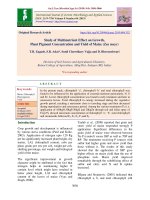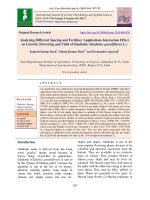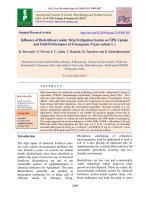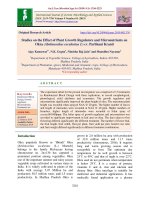Enhancement of plant growth, nodulation and yield of mungbean (Vigna radiate L.) by microbial preparations
Bạn đang xem bản rút gọn của tài liệu. Xem và tải ngay bản đầy đủ của tài liệu tại đây (235.17 KB, 7 trang )
Int.J.Curr.Microbiol.App.Sci (2019) 8(8): 2382-2388
International Journal of Current Microbiology and Applied Sciences
ISSN: 2319-7706 Volume 8 Number 08 (2019)
Journal homepage:
Original Research Article
/>
Enhancement of Plant Growth, Nodulation and Yield of
Mungbean (Vigna radiate L.) by Microbial Preparations
Farrukh Matkarimov1,2, Dilfuza Jabborova1* and Saidmurot Baboev1
1
Institute of Genetics and Plant Experimental Biology, Academy of Sciences of Uzbekistan,
Kibray 111226, Tashkent region, Uzbekistan
2
Chirchik State Pedagogical Institute of Tashkent region
*Corresponding author
ABSTRACT
Keywords
Mungbean,
Microbial
preparations,
Inoculation, Plant
growth, Nodulation,
Yield
Article Info
Accepted:
20 July 2019
Available Online:
10 August 2019
A field experiment was conducted to study the effect of Rhizobium and PlantaStim
preparations on plant growth, nodulation and yield of mungbean (Vigna radiate L.).
Experimental treatments included of uninoculation control, inoculation with Rhizobium 3,
Rhizobium 9 and PlantaStim preparations. The Rhizobium 3 and Rhizobium 9 preparations
showed better results over control and PlantaStim. The results showed that Rhizobium 9
preparation inoculation rose plant height by 27%, root length by 77% and root dry weight
by 78%. Inoculation with Rhizobium 3 preparation significantly increased the plant height,
root length, shoot dry weight, root dry weight, pods length, number of nodules, number of
pods per plant, number of seed per plant, number of seed per pod and 1000 seed weight of
mungbean compared to control. PlantaStim preparation inoculation increased the number
of pods per plant by 25%, number of seed per plant by 28% and weight of seed per plant by
34 % compared to control. It is concluded that a significant positive effect of inoculation
with Rhizobium 3 and Rhizobium 9 on growth, nodulation and yield of mungbean plants
compared to control and PlantaStim.
Introduction
Mungbean (Vigna radiate L.) is an important
legume for human nutrition and a major
protein (1). Seeds contain 60-65%
carbohydrates, fat (1-1.5%) and 3.5-4.5%
fibre. It plays also in enhancing the soil
fertility by fixing the atmospheric nitrogen
(2). Symbiotic relationships of the rhizobia
also play a key role in improving the quality
and productivity of the soil. Rhizobial species
such
as
Rhizobium,
Bradyrhizobium,
Sinorhizobium and Mesorhizobium are
commonly used as inoculants in various parts
of the world for improving the yield of
legumes. When seed inoculation with
Rhizobium, colonize plant roots, increase
plant growth, development, noduation and
yield of legume crops by multifarious
mechanisms, such as control of soil borne and
systemic pathogens, beneficial activities in
terms of nutrients availability and production
of enzymes and plant growth regulators (3-9).
Environmentally, the use of specific
2382
Int.J.Curr.Microbiol.App.Sci (2019) 8(8): 2382-2388
rhizobium may be preferable to the use of
nonspecific chemical fertilizers and pesticides
because of cost, time effectiveness, and
contributions to sustainable agricultural
systems.
There are many reports on the positive effects
of inoculation of legumes with Rhizobium
spp. Several studies have shown that rhizobial
inoculants increased in nodulation, N2
fixation and nitrogenize activity of nodulated
legumes (10-12). The inoculation with
Rhizobium spp. had enhanced nodulation and
nitrogen fixation, plant biomass and grain
yield in various leguminous species including
mungbean, chickpea, bean and soybean (1316). Daramola et al., (17) reported that
increased nodule number, nodule weight,
nitrogen fixation, dry matter and nitrogen
yield of soybean when inoculated with
Brudyrhizobium japonicum strain.
Microbial preparations to mungbean for better
plant height, root length, dry biomass,
nodulation and yield components of
mungbean was investigated in field
conditions. The aim of this field research was
to study the possibility of cultivation of
mungbean by applying seed inoculation with
selected
highly
effective
microbial
preparation.
Materials and Methods
Mungbean (Vigna radiate L.) seed cultivar
Zilola was used for field experiments.
Rhizobium 3 and Rhizobium 9 preparations
were obtained from the culture collection of
the Department of Microbiology and
Biotechnology, National University of
Uzbekistan. PlantaStim (trichodermin) was
obtained from private company of AnGuzal
Agroservis, Uzbekistan.
A field experiment was conducted to study
effect of Rhizobium 3, Rhizobium 9 and
PlantaStim on plant growth, nodulation and
yield of Mungbean (Vigna radiate L.). The
experiment were carried out in randomized
block design with three replications a field
experiments at the Institute of Genetics and
Plant Experimental Biology, Kibray, Tashkent
region, Uzbekistan. Experimental treatments
included of uninoculation control, inoculation
with Rhizobium 3, Rhizobium 9 and
PlantaStim. Seeds were sown on 13 and 14
April for the year of 2018. A plot size of 10
m2 with row spacing 30 cm and plant spacing
of 10 cm were used. Harvesting was
performed on 18 and 19 July 2018. After 94
and 95 days plant height, length of roots and
pods, dry weight of roots, dry weight of
stems, dry weight of pods, dry weight of
grains, number of pods and grains per plant,
number of grains per pod, 1000 grains weight
were determined.
Experimental data were analysed with the
StatView Software using ANOVA. The signifi
cance of the effect of treatment was
determined by the magnitude of the F value (P
<0.05).
Results and Discussion
An effect of inoculation of mungbean seed
either with Rhizobium 3, Rhizobium 9 and
PlantaStim preparations on plant growth,
nodulation and yield of mungbean were
conducted in field conditions. The results
showed
that
PlantaStim
preparation
inoculation increased dry weight of root by
15% and dry weight of shoot by 57%
compared to control (Table 1). The Rhizobium
3 and Rhizobium 9 showed better results over
to control and PlantaStim. Data in Table 1
indicated that Rhizobium 9 inoculation
increased plant height by 27%, root length by
77% and root dry weight by 78%, compared
to uninoculated control. When inoculation
with Rhizobium 3 preparation significantly
increased the plant height by 33%, root length
2383
Int.J.Curr.Microbiol.App.Sci (2019) 8(8): 2382-2388
by 77%, shoot dry weight by 32%, root dry
weight by 78%.
Inoculation with Rhizobium preparations
indicated increase in the height of plant,
length of root, dry weight of root and dry
weight of shoot of mungbean compared to
control. There are many studies which
showed that seed inoculation with Rhizobium
bacteria increase the height of plant, length of
root, dry weight of root and dry weight of
shoot of legume crops (18-21). Similar results
were obtained by Youseif et al., (22) in
soybean. Delic et al., (23) reported that
inoculation with bradyrhizobial strains
increased shoot dry weight by 26-33%
compared to control. Dhami and Prasad (24)
confirmed that inoculation of effective B.
japonicum strains significantly increased the
plant biomass of soybean. According to the
results of some authors, under field
conditions, growth of faba bean and
mungbean increased significantly in response
to inoculation with the most effective
rhizobial strains (25, 26).
Number of nodules of mungbean increased in
both the Rhizobium 3 and Rhizobium 9
inoculation. Rhizobium 3 had a positive
significant effect on the number of nodules
per plant that the maximum the number of
nodules per plant was obtained from
inoculation with Rhizobium 3 treatment by 52
nodules that the number of nodules per plant
increased by 8% as compared with Rhizobium
9 treatment (Figure).
Table.1 Effect of microbial preparations on plant height, root length and plant weight of
mungbean in field conditions
Treatments
Plant height
(cm)
Root length
(cm)
Shoot dry
weight (g)
Root dry
weight (g)
Control
41.20±1.57
12.40±2.29
6.72±0.42
0.38±0.02
PlantaStim
42.00±2.02
12.60±1.00
10.61±0.46*
0.44±0.05
Rhizobium 3
55.80±1.69*
22.00±1.86*
15.64±0.69*
0.68±0.08*
Rhizobium 9
52.40±2.02*
22.60±2.20*
15.14±0.66*
0.57±0.05*
Level of significance, *(P <0.05).
Table.2 Effect of microbial preparations on number of pod per plant, length of pod and weight of
pod per plant of mungbean in feild conditions
Treatments
Pod
plant-1(no.)
Pod length
(cm)
Pods weight
plant-1(g)
Control
11.80±0.84
7.98±1.62
5.60±0.40
PlantaStim
14.80±1.42
8.76±1.31
7.87±0.73
Rhizobium 3
23.00±0.62*
10.58±0.67*
17.97±2.01*
Rhizobium 9
24.60±3.31
10.57±0.53
18.45±2.03
2384
Int.J.Curr.Microbiol.App.Sci (2019) 8(8): 2382-2388
Table.3 Effect of microbial preparations on number of seed per plant, number of seed per pod,
weight of seed per plant and weight of 1000 seed of mungbean in feild conditions
Seed
plant-1(no.)
Seed
pod-1(no.)
Seed weight
plant-1(g)
1000 seed
weight (g)
90±7.72
7.60±0.82
4.89±0.45
54.40±2.20
PlantaStim
116±11,17*
7.79±1.11
6.57±0.22*
57.00±3.92
Rhizobium 3
210±14.09*
9.11±0.35*
14.91±1.98*
71.20±3.89*
Rhizobium 9
234±10.41*
9.70±0.56
16.31±1.24*
69.70±3.79*
Treatments
Control
Nodule number
Fig.1 Effect of rhizobial preparations inoculation on number of nodules of mungbean
54
53
52
51
50
49
48
47
46
45
44
*
Rhizobium 3
The
rhizobial
inoculation
with
its
considerable
positive
effects
showed
increases the number of nodules per plant.
Similar findings were reported for bean (27),
soybean (16), munbean (28) and chickpea
(29). According to the results of some
authors, B. japonicum strains improved
soybean nodulation, and increased nitrogen
fixation (17, 30). Dhami and Prasad (24)
reported that inoculation of soybean plants
with B. japonicum increased nodule number.
Raza et al., (19) reported on mungbean when
inoculated with Rhizobium strain increased
the number of nodules of mungbean.
PlantaStim preparation inoculation increased
the number of pods per plant by 25%, weight
Rhizobium 9
of pods per plant by 40%, number of seed per
plant by 28% and weight of seed per plant by
34 % compared to control (Table 2, 3). The
results showed that Rhizobium 3 and
Rhizobium 9 had a positive significant effect
on the number of pods per plant that the
maximum the number of pods per plant was
obtained from inoculation with Rhizobium 9
treatment by 24.60 pods that the number of
pods per plant increased by 108% as
compared with control treatment (Table 2).
Rhizobium 9 inoculation significantly
increased the length of pod by 32%, seed per
pod by 27% and 1000 seed weight by 28%
compared to control. Inoculation with
Rhizobium 3 significantly increased the length
of pod and 1000 seed weight compared other
2385
Int.J.Curr.Microbiol.App.Sci (2019) 8(8): 2382-2388
treatments. The maximum 1000 seed weight
was obtained from inoculation with
Rhizobium 3 treatment of by 71.20 seed
weight by 30% compared to control
treatment.
Rhizobium 3 and Rhizobium 9 preparations
used in this study have improved yield
compounds of mungbean in field conditions.
Similar results were reported by Dhami and
Prasad (24). Rhizobium sp. improved the
number of pods, the number of grains, the
weight of pods, the weight of grains, 100 and
1000 grains weight of several legumes such as
soybean (12,24,20,6,16), chickpea (31) and
mungbean (32,15,18). Raza et al., (19)
reported that Rhizobium inoculation increased
seed weight per plant by 64% compared to
uninoculated control. Delic et al. (23)
observed that the B. japonicum strain 542
inoculation increased the grain yield of
mungbean in field conditions.
2.
3.
4.
5.
6.
In conclusion, our work demonstrated that
inoculation with Rhizobium 3 and Rhizobium
9 preparations could enhance formation of
nodules on mungbean grown in field
conditions. In summary, a significant positive
effect of inoculation with Rhizobium 3 and
Rhizobium 9 preparations, on plant growth,
nodulation and yield of mungbean in field
conditions. The Rhizobial preparations could
be the most suitable inoculant preparations for
mungbean cultivation practices.
7.
8.
Acknowledgement
This work has been financed by the Ministry
of Innovational Development of the Republic
of Uzbekistan.
9.
References
1.
Khan A and Mailik MA, Determing
biological yield potential of different
mungbean cultivars. J Biol Sci, 1 (2001)
2386
575.
Razzaque MA, Haque MM, Karim MA
and Solaiman AR, Nitrogen fixating ability
of mungbean genotypes under different
levels of nitrogen application. Bangladesh
J Agril Res, 41 (2016) 163.
Arora NK, Kang SC and Maheshwari DK,
Isolation of siderophore-producing strains
of Rhizobium meliloti and their biocontrol
potential
against
Macrophomina
phaseolina that causes charcoal rot of
groundnut. Curr Sci, 8 (2001) 673.
Tilak
K,
Ranganayaki
N
and
Manoharachari C, Synergistic effects of
plant-growth promoting rhizobacteria and
Rhizobium on nodulation and nitrogen fi
xation by pigeon pea (Cajanus cajan). Eur
J Soil Sci, 57 (2006) 67.
Saha R, Saha N, Donofrio RS and
Besterbelt LL, Microbial siderophores: a
mini review. J Basic Microbiol, 52 (2012)
1.
Masciarelli O, Llanes A and Luna V, A
new
PGPR
co-inoculated
with
Bradyrhizobium
japonicum
enhances
soybean
nodulation.
Microbiological
Research, 169 (2014) 609.
Jabborova D and Davranov K, Effect of
phosphorus and nitrogen concentrations on
root colonization of Soybean (GLYCINE
MAX L.) by Bradyrhizobium japonicum
and Pseudomonas putida. International
Journal of Advanced Biotechnology and
Research(IJBR), 6 (2015) 418.
Egamberdieva D, Jabborova D and Berg
G, Synergistic interactions between
Bradyrhizobium japonicum and the
endophyte Stenotrophomonas rhizophila
and their effects on growth and nodulation
of soybean under salt stress. Plant and
Soil, 405 (2016) 35.
Egamberdieva D, Jabborova D, Wirth S,
Alam P, Alyemeni MN and Ahmad P,
Interaction of magnesium with nitrogen
and phosphorus modulates symbiotic
performance
of
soybean
with
Int.J.Curr.Microbiol.App.Sci (2019) 8(8): 2382-2388
10.
11.
12.
13.
14.
15.
16.
17.
Bradyrhizobium japonicum, and its root
architecture. Frontiers in Microbiology, 9
(2018) 1.
Carter J M, Gardner W K and Gibson A H,
Improved growth and yield of faba beans
(Vicia faba cv. fiord) by inoculation with
strains of Rhizobium leguminosarum
biovar. viciaein acid soils in south-west
Victoria. Aust J Agric Res, 94 (1994) 613.
Elsheikh EAE and Elzidany AA, Effects of
Rhizobium inoculation, organic and
chemical fertilizers on yield and physical
properties of bean seeds. Plant Foods
Human Nutr, 51 (1997) 137.
Egamberdiyeva D, Qarshieva D and
Davranov K, The use of Bradyrhizobium
japonicum to enhance growth and yield of
soybean varieties in Uzbekistan conditions.
J Plant Growth Regul, 23 (2004) 54.
Hadi EA and Elsheikh EAE, Effect of
rhizobium inoculation and nitrogen
fertilization on yield and protein content of
six chickpea (Cicer arietinum L.) cultivars
in marginal soils under irrigation. Nutr
Cycl Agroecosyst, 54 (1999) 57.
Yadegari M and Rahmani HA, Evaluation
of bean (Phaseolus vulgaris) seeds’
inoculation with Rhizobium phaseoli and
plant growth promoting Rhizobacteria
(PGPR) on yield and yield components.
African Journal of Agricultural Research,
5 (2010) 792.
Kashem MA, Mian MH and Rahman MF,
Effect of Bradyrhizobium on the yield of
mungbean (Vigna radiata L.) grown in
Ganges Tidal floodplain soil. J Agric Res,
38 (2000) 407.
Mukhtar МАE, Effect of overexpression of
AtPAP15
on
soybean-arbuscular
mycorrhizal fungi/Rhizobium symbiosis
and abiotic stress, Ph.D. thesis, South
China Agricultural University, Guangzhou,
2015.
Daramola DS, Danso SKA and Hardarson
G, Nodulation, N2 fixation and dry matter
yield of soybean [Glycine Max (L.)
18.
19.
20.
21.
22.
23.
24.
2387
Merrill] inoculated with effective and
ineffective Bradyrhizobium japonicum
strains. Soil Biochem, 26 (1994) 883.
Sharma S, Growth, physiological and yield
aspects of mungbean (Vigna radiata) as
affected by inoculation treatment by
different strains of Bradyrhizobium culture.
I J Res Crop, 2 (2001) 112.
Raza W, Akhtar M, Arshad M &Yousaf S,
Growth, nodulation and yield of mungbean
(Vigna radiata L.) as influenced by
coinoculation with rhizobium and plant
growth promoting rhizobacteria. Pak J
Agri Sci, 41 (2004) 125.
Egamberdieva D, Jabborova D &Wirth S,
Alleviation of salt stress in legumes by coinoculation with Pseudomonas and
Rhizobium. Plant Microbe SymbiosisFundamentals and Advances, (2013) 4.
Egamberdieva D, Wirth S, Jabborova D,
Räsänen LA and Liao H, Coordination
between
Bradyrhizobium
and
Pseudomonas alleviates salt stress in
soybean through altering root system
architecture. Journal of Plant Interactions,
12 (2017) 100.
Youseif SH, Abd El-Megeed FH, Khalifa
MA and Saleh SA, Symbiotic effectiveness
of Rhizobium (Agrobacterium) compared
to
Ensifer
(Sinorhizobium)
and
Bradyrhizobium genera for soybean
inoculation under field conditions. Res. J.
Microbiol, 9 (2014) 151.
Delic
D,
Stajkovic-Srbinovic
O,
Kuzmanovic D, Rasulic N, Mrvic V,
Andjelovic S and Knezevic-Vukcevic J,
Effect of bradyrhizobial inoculation on
growth and seed yield of mungbean in
Fluvisol and Humofluvisol. African
Journal of Microbiology Research, 5
(2011) 3946.
Dhami N &Prasad BN, Effect of
Bradyrhizobium japonicum on biomass
and crop yield of soybean [Glycine Max
(L.) Merr.]. Journal of Microbial World, 8
(2006) 15.
Int.J.Curr.Microbiol.App.Sci (2019) 8(8): 2382-2388
25. Sharma P and Khurana AS, Effect of
native populations of rhizobia nodulating
single
and
multi-strain
Rhizobium
chickpea (Cicer arietinum) in Tunisia.
inoculants on biological nitrogen fixation
World J Microbiol Biotechnol, 23 (2007)
in summer mungbean, Vigna radiata (L.)
1195.
Wilczek. Res Dev Rep, 14 (1997) 8.
30. Zhang H, Prithiviraj B, Charles T C,
26. Youseif SH, Abd El-Megeed FH and Saleh
Driscoll B T and Smith D L, Low
SA, Improvement of faba bean yield using
temperature
tolerant
Bradyrhizobium
rhizobium/agrobacterium inoculant in lowjaponicum strains allowing improved
fertility sandy soil. Agronomy, 7 (2017) 1.
nodulation and nitrogen fixation of
27. Daba S and Haile M, Effects of rhizobial
soybean in a short season (cool spring)
inoculant and nitrogen fertilizer on yield
area. Europ. J. Agronomy, 19 (2003) 205and nodulation of common bean. J Plant
213.
Nutr, 23 (2000) 581.
31. Sattar MA, Quader MA and Danso SKA,
28. Hafeez FY, Hameed S, Ahmad T and
Nodulation, nitrogen fixation and yield of
Malik KA, Competition between effective
chickpea as influenced by host cultivar and
and
less
effective
strains
of
Bradyrhizobium strain differences. Soil
Bradyrhizobium spp. for nodulation on
Biol Biochem, 27 (1995) 725.
Vigna radiata. Biol. Fertil. Soils, 33 (2001) 32. Thakur AK and Panwar JDS, Effect of
382.
Rhizobium -VAM interactions on growth
29. Ben Romdhane S, Tajini F, Trabelsi M,
and yield in mungbean (Vigna radiata L.)
Aouani M and Mhamdi R, Competition for
under field conditions. Indian J Plant
nodule formation between introduced
Pathol, 38 (1995) 62.
strains of Mesorhizobium ciceri and the
How to cite this article:
Farrukh Matkarimov, Dilfuza Jabborova and Saidmurot Baboev. 2019. Enhancement of Plant
Growth, Nodulation and Yield of Mungbean (Vigna radiate L.) by Microbial Preparations.
Int.J.Curr.Microbiol.App.Sci. 8(08): 2382-2388. doi: />
2388
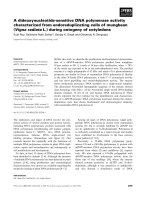


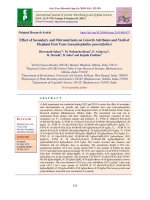
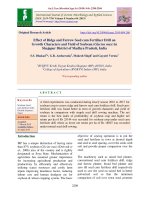
![Effect of fertility levels and stress mitigating chemicals on nutrient uptake, yield and quality of mungbean [Vigna radiata (L.) Wilczek] under loamy sand soil of Rajasthan](https://media.store123doc.com/images/document/2020_01/09/medium_ftp1578562755.jpg)
